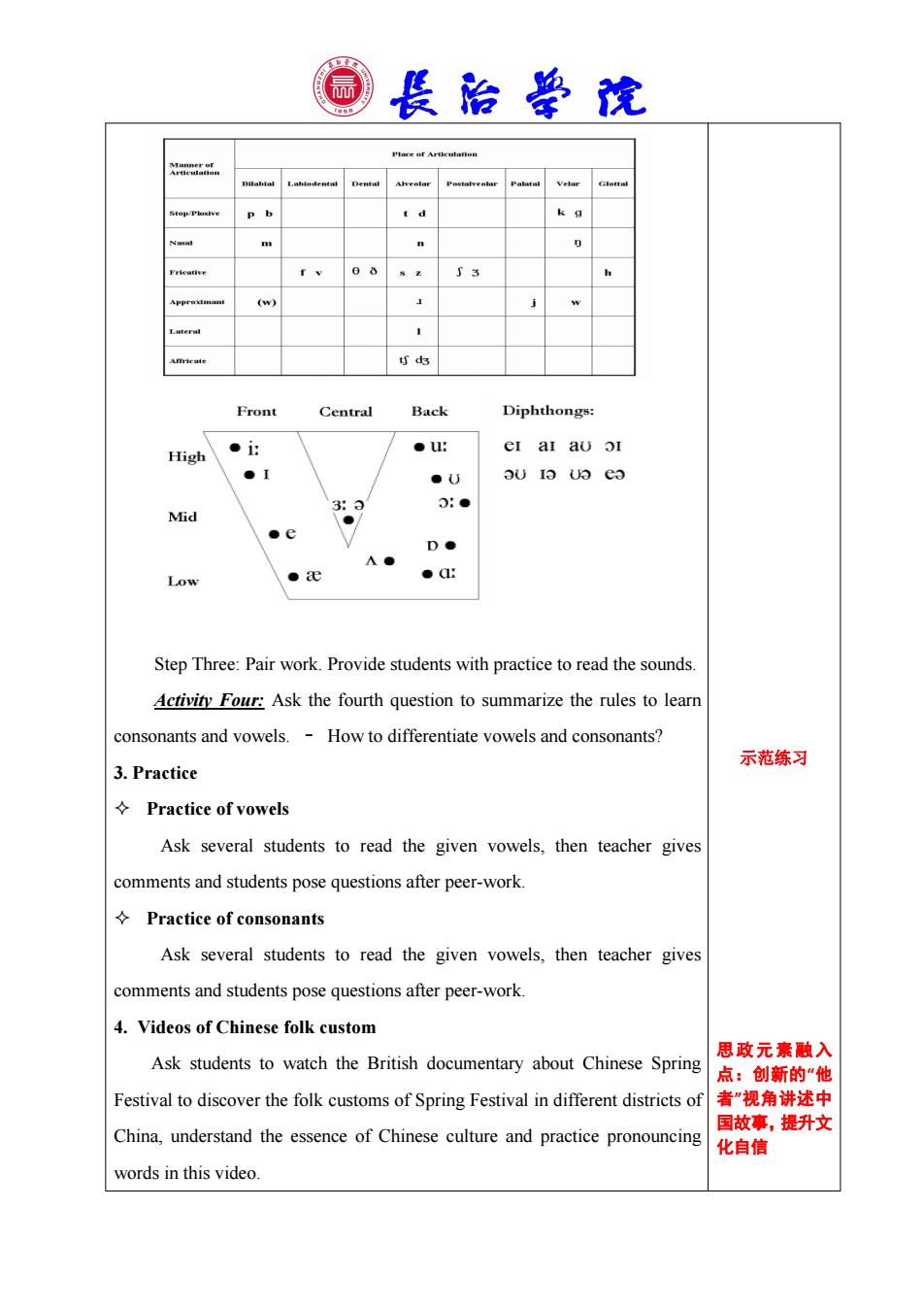
简畏治堂院 Front Central Back Diphthongs: High ●i: ●出: eI ar ao or ●U 0:● Mid ●e D● Low ● ●a: Step Three:Pair work.Provide students with practice to read the sounds Activity Four:Ask the fourth question to summarize the rules to learn consonants and vowels.How to differentiate vowels and consonants? 示范练习 3.Practice ◇Practice of vowels Ask several students to read the given vowels,then teacher gives comments and students pose questions after peer-work Practice of consonants Ask several students to read the given vowels,then teacher gives comments and students pose questions after peer-work. 4.Videos of Chinese folk custom Ask students to watch the British documentary about Chinese Spring 思政元素融入 点:创新的“他 Festival to discover the folk customs of Spring Festival in different districts of 者”视角讲述中 国故事,提升文 China,understand the essence of Chinese culture and practice pronouncing 化自信 words in this video
Step Three: Pair work. Provide students with practice to read the sounds. Activity Four: Ask the fourth question to summarize the rules to learn consonants and vowels. – How to differentiate vowels and consonants? 3. Practice Practice of vowels Ask several students to read the given vowels, then teacher gives comments and students pose questions after peer-work. Practice of consonants Ask several students to read the given vowels, then teacher gives comments and students pose questions after peer-work. 4. Videos of Chinese folk custom Ask students to watch the British documentary about Chinese Spring Festival to discover the folk customs of Spring Festival in different districts of China, understand the essence of Chinese culture and practice pronouncing words in this video. 示范练习 思政元素融入 点:创新的“他 者”视角讲述中 国故事,提升文 化自信
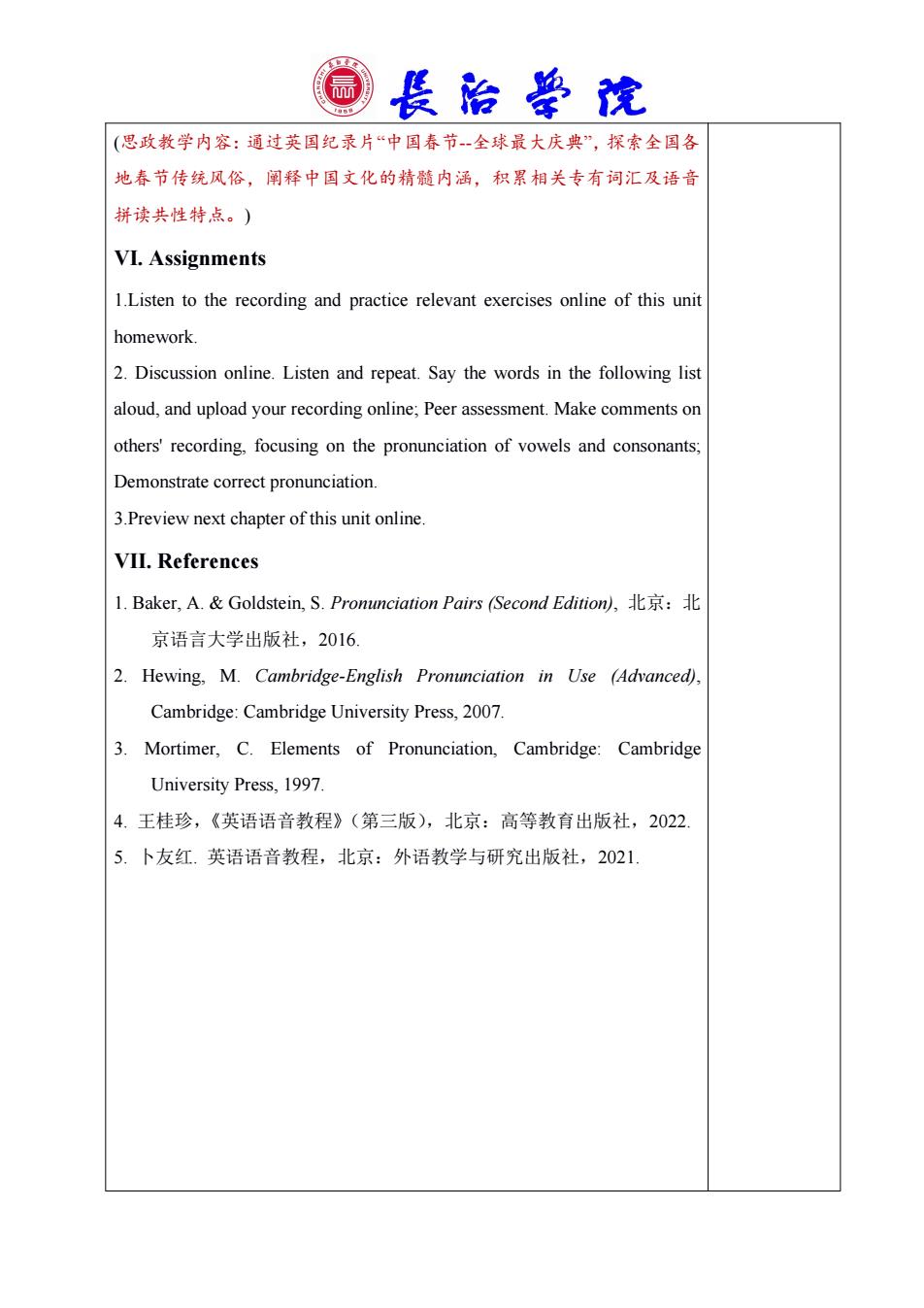
司畏治幸沈 (思政教学内容:通过英国纪录片“中国春节全球最大庆典”,探索全国各 地春节传统风俗,阐释中国文化的精髓内涵,积累相关专有词汇及语音 拼读共性特点。) VI.Assignments 1.Listen to the recording and practice relevant exercises online of this unit homework. 2.Discussion online.Listen and repeat.Say the words in the following list aloud,and upload your recording online;Peer assessment.Make comments on others'recording,focusing on the pronunciation of vowels and consonants. Demonstrate correct pronunciation 3.Preview next chapter of this unit online. VII.References l,Baker,A.&Goldstein,S.Pronunciation Pairs (Second Edition),北京:北 京语言大学出版社,2016. 2.Hewing,M.Cambridge-English Pronunciation in Use (Advanced). Cambridge:Cambridge University Press,2007. Mortimer,C.Elements of Pronunciation,Cambridge:Cambridg University Press,1997. 4.王桂珍,《英语语音教程》(第三版),北京:高等教育出版社,2022 5.卜友红.英语语音教程,北京:外语教学与研究出版社,2021
(思政教学内容:通过英国纪录片“中国春节-全球最大庆典”,探索全国各 地春节传统风俗,阐释中国文化的精髓内涵,积累相关专有词汇及语音 拼读共性特点。) VI. Assignments 1.Listen to the recording and practice relevant exercises online of this unit homework. 2. Discussion online. Listen and repeat. Say the words in the following list aloud, and upload your recording online; Peer assessment. Make comments on others' recording, focusing on the pronunciation of vowels and consonants; Demonstrate correct pronunciation. 3.Preview next chapter of this unit online. VII. References 1. Baker, A. & Goldstein, S. Pronunciation Pairs (Second Edition), 北京:北 京语言大学出版社,2016. 2. Hewing, M. Cambridge-English Pronunciation in Use (Advanced), Cambridge: Cambridge University Press, 2007. 3. Mortimer, C. Elements of Pronunciation, Cambridge: Cambridge University Press, 1997. 4. 王桂珍,《英语语音教程》(第三版),北京:高等教育出版社,2022. 5. 卜友红. 英语语音教程,北京:外语教学与研究出版社,2021
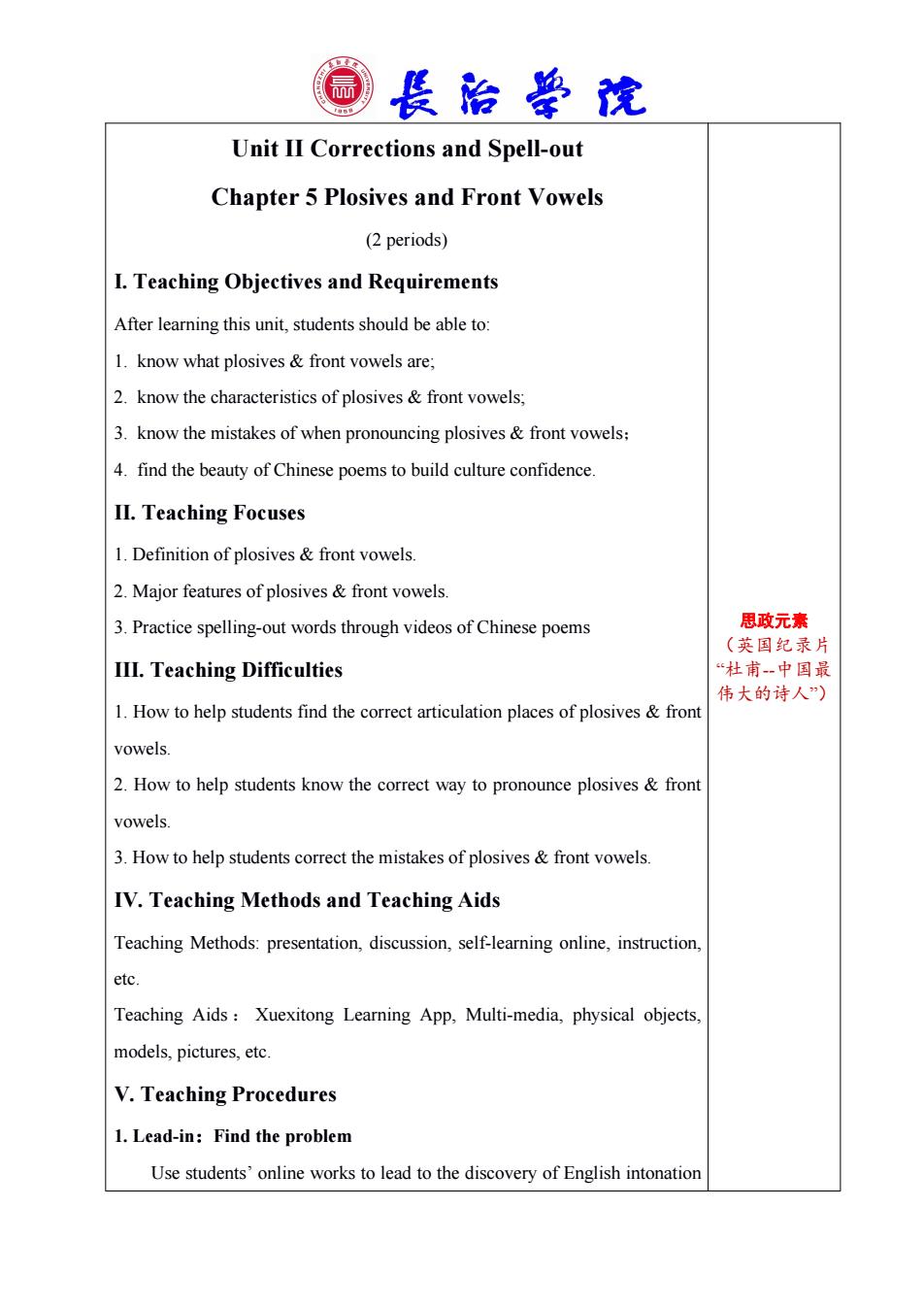
简畏胎幸沈 Unit II Corrections and Spell-out Chapter 5 Plosives and Front Vowels (2 periods) I.Teaching Objectives and Requirements After learning this unit,students should be able to: 1.know what plosives&front vowels are; 2.know the characteristics of plosives&front vowels; 3.know the mistakes of when pronouncing plosives front vowels: 4.find the beauty of Chinese poems to build culture confidence. II.Teaching Focuses 1.Definition of plosives&front vowels. 2.Major features of plosives&front vowels. 3.Practice spelling-out words through videos of Chinese poems 思政元素 (英国纪录片 III.Teaching Difficulties “杜甫-中国最 伟大的诗人”) 1.How to help students find the correct articulation places of plosives front vowels. 2.How to help students know the correet way to pronounce plosives&fron vowels. 3.How to help students correct the mistakes of plosives&front vowels. IV.Teaching Methods and Teaching Aids Teaching Methods:presentation,discussion,self-learning online,instruction. ete Teaching Aids:Xuexitong Learning App,Multi-media,physical objects models,pictures,etc. V.Teaching Procedures 1.Lead-in:Find the problem Use students"online works to lead to the discovery of English intonation
Unit II Corrections and Spell-out Chapter 5 Plosives and Front Vowels (2 periods) I. Teaching Objectives and Requirements After learning this unit, students should be able to: 1. know what plosives & front vowels are; 2. know the characteristics of plosives & front vowels; 3. know the mistakes of when pronouncing plosives & front vowels; 4. find the beauty of Chinese poems to build culture confidence. II. Teaching Focuses 1. Definition of plosives & front vowels. 2. Major features of plosives & front vowels. 3. Practice spelling-out words through videos of Chinese poems III. Teaching Difficulties 1. How to help students find the correct articulation places of plosives & front vowels. 2. How to help students know the correct way to pronounce plosives & front vowels. 3. How to help students correct the mistakes of plosives & front vowels. IV. Teaching Methods and Teaching Aids Teaching Methods: presentation, discussion, self-learning online, instruction, etc. Teaching Aids : Xuexitong Learning App, Multi-media, physical objects, models, pictures, etc. V. Teaching Procedures 1. Lead-in:Find the problem Use students’ online works to lead to the discovery of English intonation 思政元素 (英国纪录片 “杜甫-中国最 伟大的诗人”)
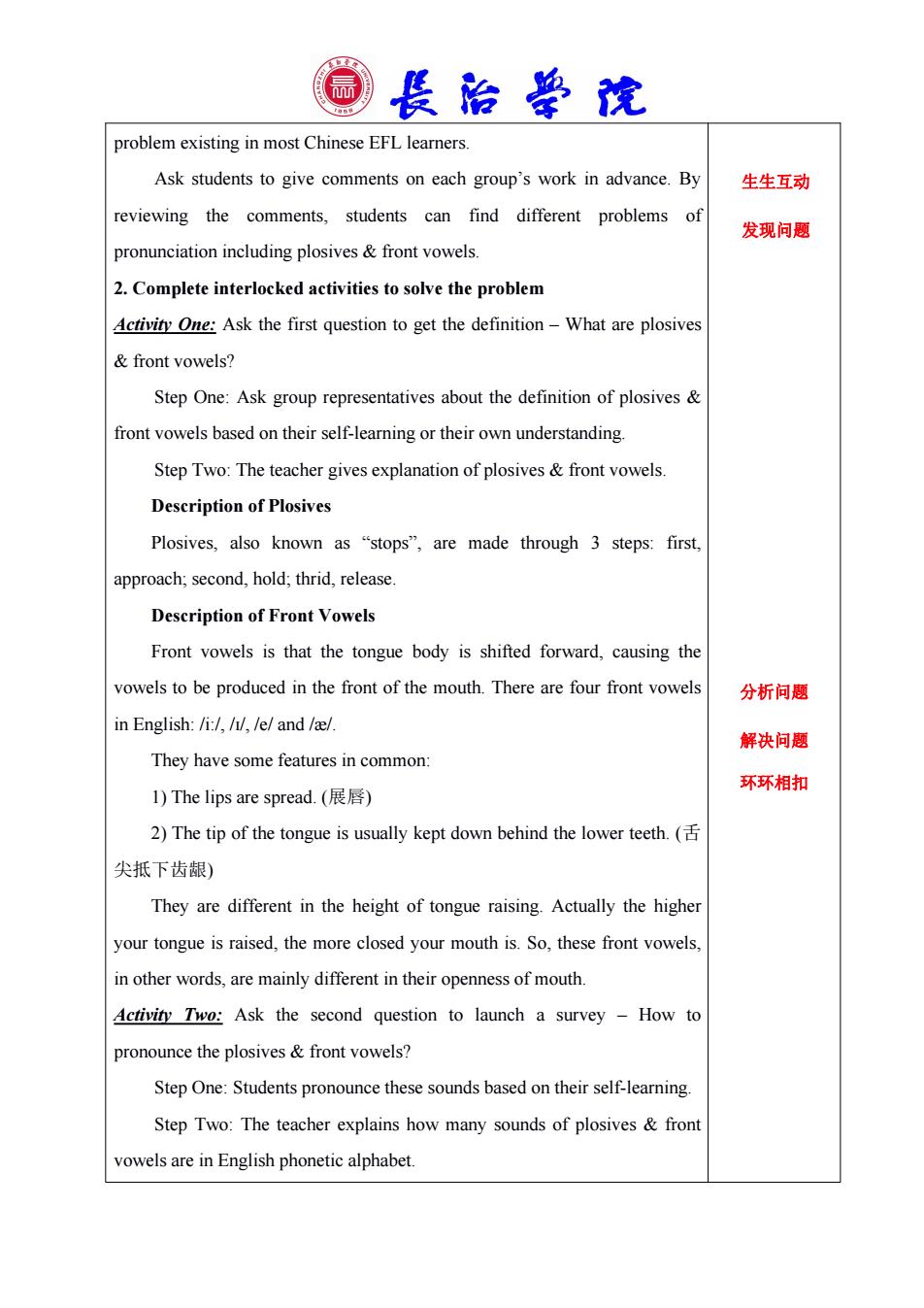
简畏胎莹沈 problem existing in most Chinese EFL learners. Ask students to give comments on each group's work in advance.By 生生互动 eviewing the comments,students can find different problems of 发现问题 pronunciation including plosives&front vowels 2.Complete interlocked activities to solve the problem Activiny One:Ask the first question to get the definition-What are plosives &front vowels? Step One:Ask group representatives about the definition of plosives& front vowels based on their self-learning or their own understanding. Step Two:The teacher gives explanation of plosives&front vowels. Description of Plosives Plosives,also known as "stops".are made through 3 steps:first pproach;second,hold;thrid,release. Description of Front Vowels Front vowels is that the tongue body is shifted forward,causing the vowels to be produced in the front of the mouth.There are four front vowels 分析问题 in English:/:/,///e/and /a/. 解决问题 They have some features in common: 环环相扣 I)The lips are spread.(展唇) 2)The tip of the tongue is usually kept down behind the lower teeth. 尖抵下齿龈) They are different in the height of tongue raising.Actually the higher your tongue is raised,the more closed your mouth is.So,these front vowels. in other words,are mainly different in their openness of mouth. Activiny Two:Ask the second question to launch a survey-How to pronounce the plosives&front vowels? Step One:Students pronounce these sounds based on their self-learning. Step Two:The teacher explains how many sounds of plosives&fron vowels are in English phonetic alphabet
problem existing in most Chinese EFL learners. Ask students to give comments on each group’s work in advance. By reviewing the comments, students can find different problems of pronunciation including plosives & front vowels. 2. Complete interlocked activities to solve the problem Activity One: Ask the first question to get the definition – What are plosives & front vowels? Step One: Ask group representatives about the definition of plosives & front vowels based on their self-learning or their own understanding. Step Two: The teacher gives explanation of plosives & front vowels. Description of Plosives Plosives, also known as “stops”, are made through 3 steps: first, approach; second, hold; thrid, release. Description of Front Vowels Front vowels is that the tongue body is shifted forward, causing the vowels to be produced in the front of the mouth. There are four front vowels in English: /i:/, /ɪ/, /e/ and /æ/. They have some features in common: 1) The lips are spread. (展唇) 2) The tip of the tongue is usually kept down behind the lower teeth. (舌 尖抵下齿龈) They are different in the height of tongue raising. Actually the higher your tongue is raised, the more closed your mouth is. So, these front vowels, in other words, are mainly different in their openness of mouth. Activity Two: Ask the second question to launch a survey – How to pronounce the plosives & front vowels? Step One: Students pronounce these sounds based on their self-learning. Step Two: The teacher explains how many sounds of plosives & front vowels are in English phonetic alphabet. 生生互动 发现问题 分析问题 解决问题 环环相扣
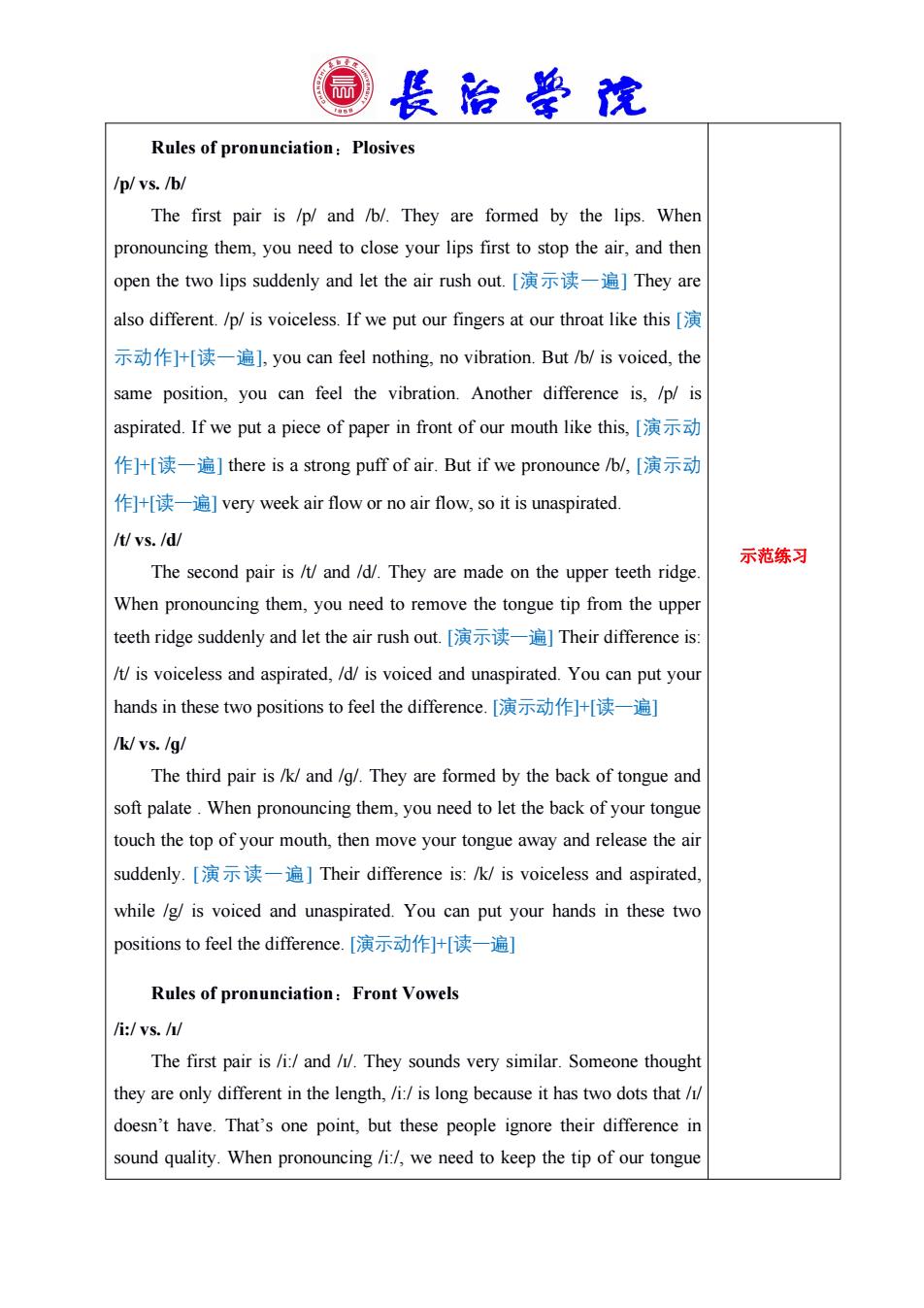
可長胎堂沈 Rules of pronunciation:Plosives /p/vs./b/ The first pair is /p/and /b/.They are formed by the lips.When pronouncing them,you need to close your lips first to stop the air,and then open the two lips suddenly and let the air rush out.【演示读-遍]They are also different./p/is voiceless.If we put our fingers at our throat like this[ 示a动作]+[读一遍]l,you can feel nothing,.no vibration.But/b/is voiced,the same position,you can feel the vibration.Another difference is,/p/is aspirated.If we put a piece of paper in front of our mouth like this,[ 作]H读-遍]there is a strong puff of air.But if we pronounce/b/,[演示动 作]+[读-遍]very week air flow or no air flow,so it is unaspirated It/vs./d/ 示范练习 The second pair is/t/and /d/.They are made on the upper teeth ridge When pronouncing them,you need to remove the tongue tip from the uppe teeth ridge suddenly and let the air rush out.[演示读-遍]Their difference is /t/is voiceless and aspirated,/d/is voiced and unaspirated.You can put your hands in these two positions to feel the difference.[演示动作]+[读-遍] /k/vs./g/ The third pair is /k/and /g/.They are formed by the back of tongue and soft palate.When pronouncing them,you need to let the back of your tongue touch the top of your mouth,then move your tongue away and release the air suddenly.[演示读-遍]Their difference is:/k/is voiceless and aspirated. while /g/is voiced and unaspirated.You can put your hands in these two positions to feel the difference.[演示动作]+[读一遍】 Rules of pronunciation:Front Vowels i:/vs.h/ The first pair is/i:/and //They sounds very similar.Someone thought they are only different in the length,/i:/is long because it has two dots that/ doesn't have.That's one point,but these people ignore their difference in sound quality.When pronouncing/i:/,we need to keep the tip of our tongue
Rules of pronunciation:Plosives /p/ vs. /b/ The first pair is /p/ and /b/. They are formed by the lips. When pronouncing them, you need to close your lips first to stop the air, and then open the two lips suddenly and let the air rush out. [演示读一遍] They are also different. /p/ is voiceless. If we put our fingers at our throat like this [演 示动作]+[读一遍], you can feel nothing, no vibration. But /b/ is voiced, the same position, you can feel the vibration. Another difference is, /p/ is aspirated. If we put a piece of paper in front of our mouth like this, [演示动 作]+[读一遍] there is a strong puff of air. But if we pronounce /b/, [演示动 作]+[读一遍] very week air flow or no air flow, so it is unaspirated. /t/ vs. /d/ The second pair is /t/ and /d/. They are made on the upper teeth ridge. When pronouncing them, you need to remove the tongue tip from the upper teeth ridge suddenly and let the air rush out. [演示读一遍] Their difference is: /t/ is voiceless and aspirated, /d/ is voiced and unaspirated. You can put your hands in these two positions to feel the difference. [演示动作]+[读一遍] /k/ vs. /ɡ/ The third pair is /k/ and /ɡ/. They are formed by the back of tongue and soft palate . When pronouncing them, you need to let the back of your tongue touch the top of your mouth, then move your tongue away and release the air suddenly. [演示读一遍] Their difference is: /k/ is voiceless and aspirated, while /g/ is voiced and unaspirated. You can put your hands in these two positions to feel the difference. [演示动作]+[读一遍] Rules of pronunciation:Front Vowels /i:/ vs. /ɪ/ The first pair is /i:/ and /ɪ/. They sounds very similar. Someone thought they are only different in the length, /i:/ is long because it has two dots that /ɪ/ doesn’t have. That’s one point, but these people ignore their difference in sound quality. When pronouncing /i:/, we need to keep the tip of our tongue 示范练习